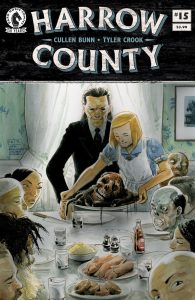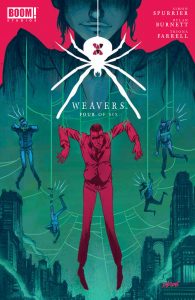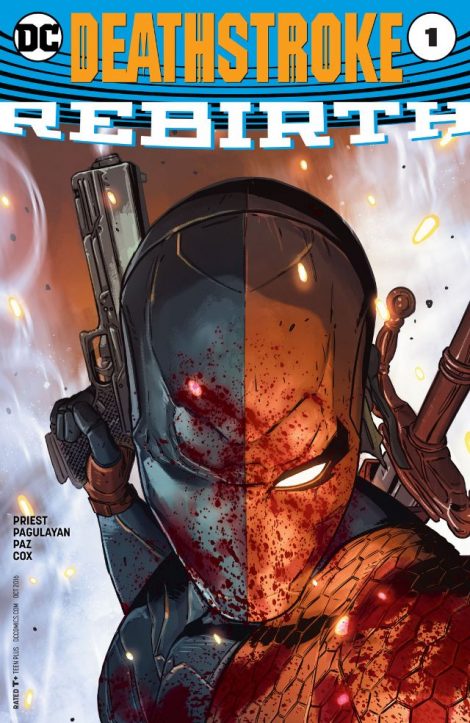This week, Kylee continued with the fantastic Harrow County after speaking with writer Cullen Bunn at San Diego Comic Con a few weeks back. She also read Weavers from BOOM! Studios, whose saving grace may be that it’s quickly ending.
Jackson took a look at Deathstroke #1 and didn’t fair much better with an issue that seems to ignore many of the character’s larger issues.
Check out the full reviews below and tell us what you’re reading in the comments!
Kylee’s Reads
Harrow County #15


Artist: Tyler Crook
Publisher: Dark Horse Comics
Source: Dark Horse DRC
★★★★★
If you didn’t get a chance to read our interview of Cullen Bunn at San Diego Comic Con 2016, check it out! We discussed a lot about lore, the characters, and some about the current arc with Emmy’s new “family,” as well as some of the things on the horizon for Harrow County.
Sometimes, I’ll read an issue and not know how to review it because I want readers to experience it for themselves without any prior knowledge. Harrow County #15 is one of those issues that I think is so well written and the illustrations so fitting, that nothing I write will do it justice. Despite that, I’ll give it my best effort to speak about this brilliant issue in broad strokes.
Throughout the duration of a leisurely stroll with one of her new “family members,” Emmy and the readers learn more about Hester Beck’s past connection to the family, what each family member’s specialization happens to be, and how she must make an extremely difficult decision in order to not only join the family, but to begin following their traditions set forth long ago. It’s a walk fraught with an undercurrent of mistrust, when Emmy deliberately makes a move to walk away from her home and into town with Odessa, and sinister parallels pointed out by Odessa regarding Emmy and Hester’s similarities.
Tyler Crook continues to leave me in awe with his artwork on this series. Not only are the characters wonderfully expressive, but gifts are showcased complementary to the text and Crook gets to flex some artistic license in making those powers both grandiose and beautifully ominous. This issue may be my favorite of the series to date as it encompasses all that I’ve come to associate with Harrow County. Do yourself a favor and pick it up as soon as possible to finish out the arc with us next issue.
Weavers #4 (of 6)


Artist: Dylan Burnett
Publisher: BOOM! Studios
Source: BOOM! Studios DRC
★★★☆☆
Sid saves a life, gets himself further entangled with the boss’ daughter, ends some lives, and gets a new assignment from the family. Past the halfway mark in this limited series and there still doesn’t seem to be much going on, despite the frenetic pace and multiple plots covered in this issue. At least, we’re getting a peek into Sid’s life before the spider and it’s… interesting? In his quest to shakedown junkies and find answers about the bombing, he’s recognized more than once (though he can’t or refuses to remember). There are only two more issues left and I still have so many questions.
Many panels stand out in issue #4, thanks to the shining work of artist Dylan Burnett and colorist Triona Farrell. The aesthetic they create lends itself to the supernatural noir theme of the series more than anything else. A full-page spread of rushing to the hospital does come with a sense of urgency thanks to the art, likewise when Sid inadvertently lets his spider out the immensity, danger, and power behind the creature is felt.
I still don’t enjoy how the font changes color, boldness, and size – frequently all within the same speech bubble. This issue comes with bonus text message bubbles that overlay panels. I’m feeling the same way I initially felt about the speech bubbles, cautiously optimistic to this new development, but if it continues into next issue, we’ll see if it gets just as old.


Jackson’s Reads
Deathstroke Rebirth #1

Authors: Christopher Priest
Artist: Carlos Pagulayan
Publisher: DC Comics
★★★★☆
There’s no character in modern superhero fiction that demands as much respects but deserves as little as Deathstroke. Deathstroke’s most famous story involves him committing statutory rape and barely beating a team full of kids who weren’t old enough to vote. He’s the world’s supposedly best “capekiller” but he’s never managed to off a single superhero on panel. A host of DC’s best and brightest writers have tried to make Slade Wilson into a formidable villain but, at best, they’ve made him the least deadly multiple gun owner ever committed to paper.
More seriously, Deathstroke suffers the same problem a lot of villains created in the mid- to late-‘70s suffers from. He was an immediate success based on his costume and attitude in the pages of New Teen Titans and as he was humanized in later stories, he became less formidable and more human, which created a new problem.
All of the stories establishing Slade as a wounded family man doing his best undercut the stories where he’s supposed to be a badass serial killer and many of the stories from the early ‘80s failed to square the new characterization with the fact that Deathstroke was still a rapist, abuser, and serial killer. It left him in a slump, too soft to be a villain and still too much of an irredeemable character to be anything resembling even an antihero.
Deathstroke as a character can only really work under a creative team with an idiosyncratic vision of the character and Christopher Priest, Marvel’s first ever black editor, and Carl Pagulayan are just the creators to do that. Deathstroke Rebirth #1 focuses on Slade as a single-minded monster devoted to humanity’s most base sin: greed.
In a story divided across two time periods, Slade’s relentlessly focused on money, the way he’s bound by contracts as well as the power he can exercise with a few dollars placed in the right hands. He manipulates markets and electoral races to keep money coming while he ignores everything else around him. That single-mindedness is also showcased in the flashbacks to Slade raising his sons.
While many stories attempt to showcase Slade as a man who’s seen the error of his ways in regards to his family, here he’s the very definition of the abusive, negligent, deadbeat dad, leaving Grant to die in the Canadian wilderness before murdering baby bears in front of his sons as a karmic punishment for their perceived transgressions. These are scenes that are profoundly hard to read but make no excuses for his villainy.
Priest’s return to comics is a great introduction to why he’s one of the medium’s most iconic voices. His scripts are dense, loaded with complicated symbols and expecting readers to keep up. It’s a script that demands readers keep up with the way money changes hands without telling them exactly why that matters.
It’s the rare Deathstroke story that doesn’t focus on the violence as much as it focuses on the words and it’s fascinating to see. When violence does rear its ugly head, it’s drawn with stylistic, wonderful expressiveness by Pagulyan.
For some readers, none of this is going to be enough to save Slade, who’s never been really strong enough of a character to carry his own solo series. Deathstroke Rebirth #1 is the rare comic that’s going to be easier to recommend based on the creative team rather than the main character. Those who’ve missed Priest’s authorial voice in the time he’s been gone from comics are in for a treat and it’s worth seeing exactly what he’s attempting to do as he tells a story of blood and bonds.

